From combe to tor, beach to clifftop, England’s second largest county is a tapestry of landscapes waiting to be explored,before sitting down to a good cream tea.
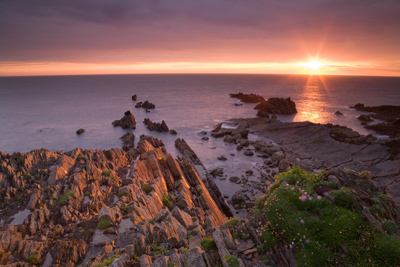
When he wasn’t being carried over the sea to Skye, song writer Sir Harold Boulton, was waxing lyrical about a certain county in the West Country. “When Adam and Eve were dispossessed, Of the garden hard by Heaven, They planted another one down in the West, ‘Twas Devon… glorious Devon!”
For Boulton, over a century ago, Devon was a land of “Combe and tor, green meadow and lane, Birds on the waving bough, Beetling cliffs by the surging main, Rich red loam for the plough.” The county still has these in abundance, despite subsequent urbanisation and the area’s popularity with holidaymakers. When Napoleon’s wars cut off access to the Mediterranean, the Brits headed west to their own English Riviera and we’ve kept up the tradition of holidaying in Devon to this day.
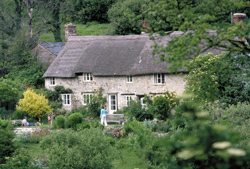 |
| A thatched cottage at Sidmouth, East Devon |
A holiday for the Brits has usually meant seaside, and Devon, sat comfortably between Somerset, Dorset and Cornwall on the great peninsula of the West Country, has two coastlines with beaches aplenty. Take your pick from the rich red sands of Sidmouth, Teignmouth and Dawlish on the south or the wide golden expanses of Woolacombe and Saunton in the north. For me, a Grockle (local name for tourist) who grew up with a beach hut at Southend-on-Sea, the other side of the country, it was enough to discover that icon of the English seaside also in abundance here. They stand in their brightly-painted glory at resorts such as Paignton, Budleigh Salterton and Woolacombe.
The coast is not just about bucket and spades, though. There are sand dunes at Braunton Burrows, sheltered estuaries for yachties at Salcombe and Dartmouth, and dramatic clifftops where Exmoor meets the sea. It can all be explored from the South West Coast Path, a 630-mile-long national trail that skirts both sides of Devon on its way from Somerset round to Dorset. As the path runs through Devon, it gives you some of the most stunning views Britain has to offer: from Great Hangman, England’s highest sea cliff and the Hartland Heritage Coast in the north, round to Start Point and Bolt Head down at Devon’s most southerly tip.
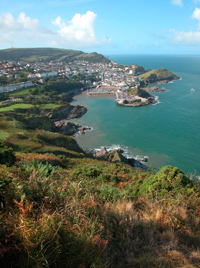 |
| Ilfracombe in North Devon |
No surprise, then, that both coasts include Areas of Outstanding Natural Beauty (in fact, Devon boasts five). The catchment area of the Rivers Taw and Torridge from Dartmoor National Park out to sea to the island of Lundy is a UNESCO biosphere, and the whole of Torbay is a UNESCO geopark. Devon’s curriculum vitae of worthy titles shows just how special and well worth exploring its landscapes are. And while we’re showing off, East Devon forms part of the World Heritage Site of the Jurassic Coast.
Between these two glorious Devon coastlines there’s much to explore, not least two National Parks (Exmoor and Dartmoor) and the beautiful and varied riverscapes, such as the Exe and Otter in the east, the Teign (pronounced “Teen”) and Dart in the south, and the Tamar running along the border with Cornwall in the west.
Devon’s few railway routes are also well-placed to let you enjoy its scenery. The Tarka Line, for example, follows the river valleys of the Yeo and Taw from the county town of Exeter for 39-miles up to Barnstaple in North Devon. From Eggesford to Barnstaple, the line forms part of the Tarka Trail, a 180-mile, figure-of-eight route tracing the journeys of Tarka the Otter in Henry Williamson’s novel.
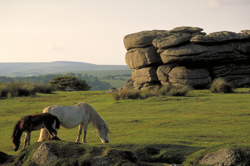 |
| Dartmoor ponies |
Try to get a window seat to enjoy the stretch of Brunel’s railway line from Exeter to Newton Abbot. Trains chug down the River Exe past Powderham Castle (home of â¨the Earl of Devon) and the wading birds of the Dawlish Warren nature reserve, around the red coast with the seaside resorts of Dawlish and Teignmouth, then up â¨the River Teign with views across to the chocolate-box villages of Shaldon and Ringmore. If you time your journey right and catch one of Devon’s spectacular sunsets, the burning red skies are reflected in the rivers below, with the dark shapes of moored yachts flashing by and the lights of riverside inns twinkling across the water.
Several heritage railways also let you step back in time for â¨a steam ride through the countryside. For example, travel â¨by steam train from Paignton to Kingswear then join a river cruise on the River Dart, to Greenway, Agatha Christie’s holiday home now open to the public with the National Trust. The Queen of Crime was born in Torquay in 1890 and, despite traveling as far as Iraq and Syria, she loved to return. She socialised at the Imperial Hotel, honeymooned with Archibald Christie at The Grand Hotel and featured Devon locations in 15 of her books. â¨The English Riviera celebrates its association with the world-famous crime writer and holds an Agatha Christie Festival each September and a Festival of Crime Writing in April.
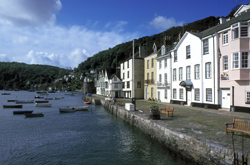 |
| Bayard’s Cove, Dartmouth |
Devon’s literary connections also include Lorna Doone Country based around Badgeworthy Water in the north. Richard Doddridge Blackmore set his ‘romance of Exmoor’ here in the 17th century. And the famously steep and pretty village â¨of Clovelly in north Devon was childhood home to author Charles Kingsley and inspired his The Water Babies, while the village of Westward Ho!, along the coast opposite Saunton Sands, was named after his 1855 novel of the same name. Dartmoor is famously the setting for Sir Arthur Conan Doyle’s Sherlock Holmes mystery, The Hound of the Baskervilles – one of the charms of the National Park is the atmospheric landscape of its rocky tors and valley. However, you are more likely to meet a friendly Dartmoor pony than a fantasy beast.
Lewtrenchard, a Jacobean manor house, now a Von Essen hotel, in the Tamar Valley, was where the Reverend Sabine Barrington Gould composed Onward Christian Soldiers and other hymns, and Devon’s musical heritage also takes you to the National Trust’s Coleton Fishacre, a charming Arts and Crafts house with an Art Deco interior, with a delightful garden running down to the sea near Kingswear. The story goes that the Doyly Carte family (of Gilbert and Sullivan and Savoy fame) were sailing along the Devon coast and spotted the valley. They decided to buy it for a holiday home.
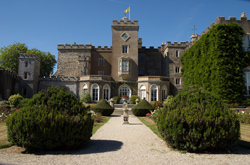 |
| Powderham Castle, home of the Earl of Devon |
The Doyly Cartes were not the only successful entrepreneurial families building homes in Devon. Knightshayes Court, near Tiverton, was built by architect William Burges in Gothic Revival style for the family of pioneer lace-maker John Heathcoat in 1869. On Dartmoor, the National Trust’s Castle Drogo was designed by Sir Edwin Lutyens for retail tycoon Julius Drewe. He had discovered in his family ancestry a Norman baron named Drogo, and wanted a castle to reflect his line of descent. One of his cousins was coincidentally rector of Drewsteignton and he bought land from him in 1910 to build his dream castle.
Nearby, hidden away at the end of
a seemingly endless winding country lane is Gidleigh Park, a mock Tudor
house built in 1928 for Australian shipping magnate, CHC MacIlwraith.
In 1977 it became a hotel, adding Enjoyâ¨England’s Hotel of the Year to
its long list of awards.
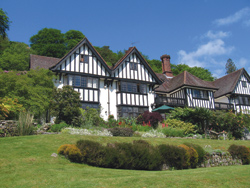 |
| Gidleigh Park |
Also on Dartmoor, in 1880 William Henry Smith (of Britain’s newsagent chain) bought the land where Bovey Castle stands today; his son Frederick built the manor house, completed in 1907. In 2004, it became the five-star resort Bovey Castle under another Devon-born entrepreneur Sir Peter de Savary and today is one of the Pride of Britain hotel collection. Lana de Savary, Peter’s wife, recently brought a touch of luxury to the Cary Arms at â¨Babbacombe, relaunching it as a boutique gastropub, with one of the best seaside locations to be found (rooms take advantage of the ever-changing views along Devon’s red coastline). On a clear day, you can see Teignmouth peaking out behind the Ness headland and right around Lyme Bay to Portland Bill in Dorset.
Devon’s built heritage is not just large-scale: near Exmouth, the National Trust’s A la Ronde is a crazy little 16-sided house with weird and wonderful interiors, built to house the mementoes of the two Parminter sisters from their grand tour in the 18th century. And, across to Ottery St Mary, there’s the small but perfectly formed Elizabethan manor of Cadhays, with beautiful gardens.
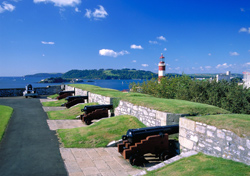 |
| Plymouth Hoe |
Elizabethan history continues over in the maritime city of Plymouth, on its historic Barbican. The house of an Elizabethan merchant has been restored to take you back in time to the Plymouth of Sir Francis Drake, the first Englishman to circumnavigate the globe. Born in Tavistock in 1540, Drake was knighted by Queen Elizabeth I and was Vice Admiral in the fleet that defeated the Spanish Armada in 1588. Plymouth is forever known as the city where, reputedly, Drake calmly continued playing a game of bowls beside the sea on the Hoe as the Armada approached.
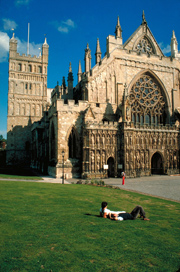 |
| Exeter cathedral |
It was also said that Drake declared the Ship Inn, off the cathedral close in Exeter, to be his favourite place on earth. The close is certainly one of mine in Devon. At its heart, the cathedral, formerly a Norman Romanesque church, was rebuilt around 1265 in Decorated Gothic style. Enter through the beautiful West Front, with its tiers of saints and angels. Inside, after admiring the nave with the longest unbroken Gothic ceiling in the world, look under the seats of the choir for the oldest set of misericord carvings in England.
On Cathedral Close sits the Royal Clarence Hotel, built in 1769 and now one of the ABode Hotels, jointly run by acclaimed Exeter-born chef, Michael Caines. Caines made his name at Gidleigh Park and is still executive chef there. He’s one of Devon’s growing list of top chefs, with Hugh Fearnley-Whittingstall in Axminster, the Tanners in Plymouth, Simon Hulstone at the Michelin-starred Elephant in Torquay and Mark Streeter at the Dart Marina.
 |
| Cream tea at Docton Mill Gardens tearoom |
While the county might now be famed for its fine dining, the regional dish remains the much-loved Devon â¨cream tea. There’s an enormous choice of places to try it, including any National Trust tearoom, or head for the Georgian Tearoom in Topsham, Docton Mill Gardens tearoom near Hartland, or quaint and quirky Angels on the Babbacombe Downs. It’s certainly a heavenly mixture: scones (of various styles from fruit to wholemeal), jam and thick clotted cream. The perfect indulgence after a long walk on Dartmoor or along the coastal path.
Further information
- Visiting Devon:
for further information on where to stay and what to do in Devon, to go â¨www.visitdevon.co.uk. Tourist Information Centres: Barnstaple, â¨tel: (01271) 375000; Dartmouth, tel: (01803) 834224; Exeter, â¨tel: (01392) 665700; Torquay, tel: (01803) 211211.
Editor’s Choice
- Agatha Christie Mile: on the English Riviera explores locations connected with the crime writer. www.englishriviera.co.uk/agathachristie.
- Blackdown Hills walks: this Area of Outstanding Natural Beauty includes a less well-trod part of Devon that’s a pleasure to explore. The website has maps and walking and cycling routes to follow, including one that takes you to the Wolford Chapel near Dunkeswell, which contains the tomb of Lieutenant-Governor John Simcoe who was governor of Upper Canada in the 18th century. The tiny chapel is maintained by the Heritage Foundation of Ontario, Canada. Another walk takes you up to the Wellington Monument, erected to mark the Duke of Wellington’s victory at the Battle of Waterloo.
- Braunton Burrows: important dune system at the heart of the UNESCO North Devon Biopshere and the North Devon Area of Outstanding Natural Beauty: www.northdevon-aonb.org.uk; www.northdevonbiosphere.org.uk.
- Circular walk in East Devon: (allow a half day) â¨from Budleigh Salterton to Otterton, including River Otter and Heritage Coast, via tearoom/restaurant â¨at Otterton Mill. One â¨of many walks on www.â¨southwestcoastpath.com.
- Combe House Hotel: (3-star), Honiton, nr Exeter. Elizabethan manor house hotel with two rosette restaurant in peaceful countryside. Tel: (01404) 540400; www.thishotel.com.
- Dart Marina Hotel: (4-star), Dartmouth. Luxury hotel on the waterside with spa and fine dining. Bedrooms with great views. Tel: (01803) 832580; www.dartmarina.com. And for ideas on what to see and do in Dartmouth, go to: www.discoverdartmouth.com.
- Docton Mill Gardens: Hartland, N Devon. With the Best Tea Room (2009 North Devon Food & Drink Awards). Tel: (01237) 441369; â¨www.doctonmill.co.uk.
- English Riviera Global Geopark: learn more about and explore the fascinating geology of the English Riviera coastline, now part of the European Geopark Network: www.englishrivierageopark.org.uk.
- Exeter Cathedral: the
church of St Peter in the county town of Exeter, founded in 1050, with
wonderful misericords under the choir seats. Set in a pretty cathedral
close where you’ll find the Royal Clarence Hotel, now an ABode Hotel: www.exeter-cathedral.org.uk. - Exeter guided tours:
the cathedral city has all sorts of treasures tucked away, from Roman walls through medieval Underground Passages to ultra modern Princesshay shopping centre. A great way to get to know it all is by joining in one of the free Red Coat Guided Tours, that depart daily from in front of the ABode Royal Clarence Hotel in Cathedral Yard (above) and outside the Quay House Visitor Centre. Tel: (01392) 265203.
- Gidleigh Park Hotel: (4-star) cosy yet luxurious country house hotel on Dartmoor, in its own gardens and grounds, with the four-rosette, two Michelin star restaurant of Michael Caines. Tel: (01647) 432367; www.gidleigh.com.
- Spekes Mill Mouth: near Milford. North Devon’s tallest waterfall, on the stunning Hartland Peninsula. www.hartlandpeninsula.co.uk.
- Steam train rides: Steam train rides. â¨Take a nostaglic trip on one of Devon’s heritage railways. â¨www.heritagerailways.com.
- The Cary Arms: (5-star inn), Babbcombe Beach, S Devon. Relaunched as a stylish boutique hotel and gastropub with fabulous seaside location. Tel: (01803) 327110.
- The Jack in the Green Inn: Rockbeare, near Exeter. Winner of the Taste of the West Awards 2009/2010. Tel: (01404) 822240; www.jackinthegreen.uk.com.
- The Nobody Inn: Doddiscombsleigh, nr Exeter. Award-winning 16th-century pub famed for its wine, whisky and cheese lists. â¨Tel: (01647) 252394; â¨www.nobodyinn.co.uk.
- Torre Abbey: Torquay, South Devon. Former abbey converted into a country home for the Cary family, now an art gallery, with gardens and cafe. Watch out for the Damien Hirst exhibit this summer. Tel: (01803) 293593; www.torre-abbey.org.uk.
- Walk along River Bovey: from Bovey Tracey, delightful walk
along the River Bovey and back through National Trust’s Parke Estate,
through park and woodland. This walk and many others are on the AA website (click on Travel, then Walks and Rides). Enjoy tea or lunch at the Riverside Mill in Bovey, exhibition space/shop of the Devon Guild of Craftsmen. -

Wildlife: Devon has some fabulous ‘zoos’. Celebrating its 25th birthday this year, the small but endlessly fascinating Shaldon Wildlife Trust, where I first met meercats and the tiny Emperor tamarins, is near the Smugglers Tunnel to Ness Beach in the ‘chocolate-box’ village of Shaldon, sitting across the River Teign (Teen) from Teignmouth (Tinmuth). At the other end of the scale is Paignton Zoo, where, among many types of animal, you can meet the new baby giraffe, Tonda, born this February. There’s also Living Coasts, Torquay’s coastal zoo and conservation charity.
Images: visitbritainimages.com and courtesy of Docton Mill Gardens, Hartland Peninsula, North Devon AONB.

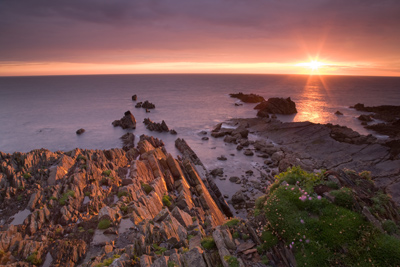




 © 2024
© 2024